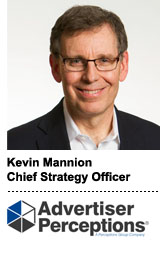 Google and Amazon still dominate the demand-side platform category, but next-tier players have opportunities to win market share and for the first time there are signs that Google’s iron grip may be softening, according to the half-yearly Advertiser Perceptions DSP Wave released Wednesday (?).
Google and Amazon still dominate the demand-side platform category, but next-tier players have opportunities to win market share and for the first time there are signs that Google’s iron grip may be softening, according to the half-yearly Advertiser Perceptions DSP Wave released Wednesday (?).
The report is based on surveys of almost 500 brand and agency buyers during the first half of 2018.
“There probably will be consolidation, but right now use of multiple DSPs is still prevalent and probably 10-15 are getting significant business,” said Kevin Mannion, Advertiser Perceptions’ chief strategy officer.
The Trade Desk, Oath’s One (with BrightRoll still the driving DSP brand), the Adobe Advertising Cloud and MediaMath have strengthened their positions and have even gained ground on the leaders.
The indie opportunity
Google and Amazon are one and two across all of the top advertiser consideration metrics, including targeting, audience scale and buying intention, according to the report. But challenger DSPs are finding ways to grow and compete.
The marketer in-housing trend, for instance, is an opportunity for independent ad tech.
The number of direct brand customers planning to work with Google remained flat, and Amazon actually ticked down from 51% to 50% in this report, though both still lead the category. But The Trade Desk and BrightRoll, the Oath DSP, each improved their mind share among brands by 10%, while MediaMath and Adobe rose 5% and 2%, respectively.
The Trade Desk in particular has always been focused on agencies, but is clearly paying more attention to brands, Mannion said.
“That’s what’s giving them the boost we see in this wave,” he said.
There could be a chance to seize agency business as well.
Google’s agency penetration dropped from 41% to 30% in the past six months, according to the report.
And Mannion said that drop doesn’t incorporate Google’s recent policy announcement restricting the Google Ad ID to Ads Data Hub, which is expected to further distance Google from agencies.
Before Amazon crashes the party, there’s also a chance to solidify self-service DSP campaigns, which have higher growth potential than managed service IO-based buys because media dollars are becoming more automated.
Amazon is the leader in terms of managed service DSP use, but that’s in part because its ad platform is relatively new and clunky. More Amazon advertising will shift to self-service moving forward, Mannion said
The Trade Desk leads all DSPs with 42% of respondents saying they use it for self-service campaigns, followed by Adobe at 37%. If those companies can maintain that lead despite Amazon’s DSP maturation, they could box the ecommerce and advertising giant out of a growth opportunity.
‘Wishful thinking’
It’s an open question whether the strength of independent DSPs in the Advertiser Perceptions wave is “wishful thinking” on the part of advertisers and the market to build alternatives to the major platforms, Mannion said.
Brands have a habit of calling for verified measurement and hyping alternatives to Google or social media without actually changing their media plans.
And Google’s inertia has propelled the company through advertiser crises before. In previous waves, negative sentiment about working with Google hasn’t translated to tangible business losses.
For example, MediaMath, The Trade Desk and Adobe strengthened their lead as the top three, respectively, in terms of “Net Promoter Score,” a metric Advertiser Perceptions uses to gauge a buyer’s likelihood to recommend a DSP vendor. But Google and Amazon are still way ahead in terms of concrete DSP pipeline metrics like “proven track record” and “audience-targeting capabilities.”
But wishes can come true. And buyer preferences for independent DSPs may not be a mirage.
Google and Amazon both lost favor as preferred single-use DSPs for the first time since Advertiser Perceptions started surveying the DSP field in 2016, while The Trade Desk, Adobe and MediaMath each gained ground.
This post was syndicated from Ad Exchanger.


More Stories
Streaming Ratings, Week of March 24: Shonda Rhimes’ The Residence Reaches First Place
CPGs Talk Tariffs, Price Hikes, and Marketing Budgets as Consumer Confidence Drops
Ticker: Chris Cuomo to Moderate NewsNation Town Hall Marking Trump’s 1st 100 Days